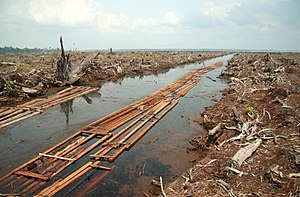Palm oil production in Indonesia
A recent publication by the NGO Rainforest Action Network (RAN) indicates that the use of palm oil by some of the biggest chocolate and snacks' producers is increasing this problem.
Looking at Indonesia's GHG emissions breakdown, climate change mitigation will mainly come from controlling forest fires and peatland conservation.
REDD+ (Reducing Emissions from Deforestation and Forest Degradation in Developing Countries) will be ‘an important component of the NDC target from [the] land-use sector’.
Typically, the company that has usage rights for the land will contract individuals to burn the supposedly "degraded" forest, thereby avoiding direct responsibility for fires, which become more likely when peatland is deforested.
[13] Over the past few years an interest in biofuel has increased as a potential clean energy source, it has become a primary use for domestic crude palm oil.
In August 2011, the governor of Aceh issued a permit for Indonesian palm oil firm PT Kallista Alam to develop around 1,600 hectares (4,000 acres) in Tripa.
[19] A major environmental threat is then the destruction of rainforests in Indonesia, which was estimated at 840 thousand hectares (2,100,000 acres) of primary forest per year from 2000 to 2012.
[24] According to the World Resources Institute, 65.5% of these greenhouse gas emissions can be attributed to land use change and forestry; the palm oil industry in Indonesia is a major contributing factor towards this trend.
[25] Industrial palm tree plantations also impacts negatively the quality of soils, water and the air because they often rely on the use of agrochemicals products, such as pesticides or fertilizers.
[28] A recent study by Rahman et al. (2018) found that when forest is converted to oil plam plantation, Soil Organic Carbon (SOC) stocks declined by 42%, 24% and 18% after 29, 39 and 49 years of conversion respectively.
[33][34] As a result of the large fires, a recurring phenomenon typically between July and October or during El Nino called the Southeast Asian haze occurs.
This is an event where air quality becomes extremely dangerous and can cause adverse health outcomes, have negative environmental, and economic impacts.
A majority of Indonesia's palm oil plantations are on steep slopes, causing "increased flooding and silt deposits in rivers and ports".
Many animals native to Southeast Asia and Indonesia are impacted by the effects of the palm oil industry and deforestation often facing threats of extinction.
Palm oil plantations in Sumatra and Borneo are one of the main areas where reticulated and blood pythons are sourced for the exotic leather industry[38] A government moratorium on the clearing of new forest was effective from 2011 to 2015.
[39] In this moratorium, opening of new palm oil plantations will be delayed to reduce conflicts, as well as requiring all central and provincial governments to re-evaluate current permits.
The expansion of the palm oil industry is driven by its profitability, and it has the potential to develop new jobs and improve the standards of living of people and small-holders when conducted sustainably.
[42] On the other side, deforestation (for example in Borneo) for oil palm plantation development also endangers indigenous tribes and local communities as it entails the destruction of living spaces or land appropriation.
[43] For example, in regions like Kalimantan, the local livelihoods of Dayak communities and their traditions of shifting cultivation, are undermined by the development of palm oil production and monocultures.
The use of slash-and-burn techniques to clear land for oil palm cultivation has led to widespread regional haze episodes impacting countries throughout Southeast Asia.
[37] The 2015 Southeast Asian Haze episode is estimated to have caused approximately 103,300 excess deaths in Indonesia, Malaysia and Singapore according to mortality models.
[47] The palm oil industry in Indonesia has been shown to have contributed to state revenue, provide employment for people in rural areas, and increase farmers income.
The indigenous people tend to see more negative social impacts such as food insecurity, human rights abuse, land disputes, and disregard for the local environment.
For his work in continuing to produce evidence in the face of threats and intimidation he received the 2019 John Maddox prize from the charity Sense about Science.
[50] Indonesia is the largest producer of palm oil across the world and is rapidly expanding its plantations and workforce to face a growing global demand.
[53] While children are rarely employed by palm oil plantations, they are often working there, helping their fathers and mothers meet their targets to receive full wages.
[52] Children often work in the fields and face the risk of injury from chemical exposure, carrying heavy loads, and dangerous farming practices.
[55] Chemicals posing major health risks like Nitrogen oxides (NOX) and Carbon monoxides (CO) are also released during peatland fires.
A study done in 2015 showed that in Central Kalimantan the particulate pollution and toxic gases released by peatland fires was so severe that 33% of deaths due to cardiovascular disease that year were attributed to the poor air quality.
In Indonesia, women are often hired under casual arrangements, exempting them from permanent employment, health insurance, pensions, and other social security benefits.

